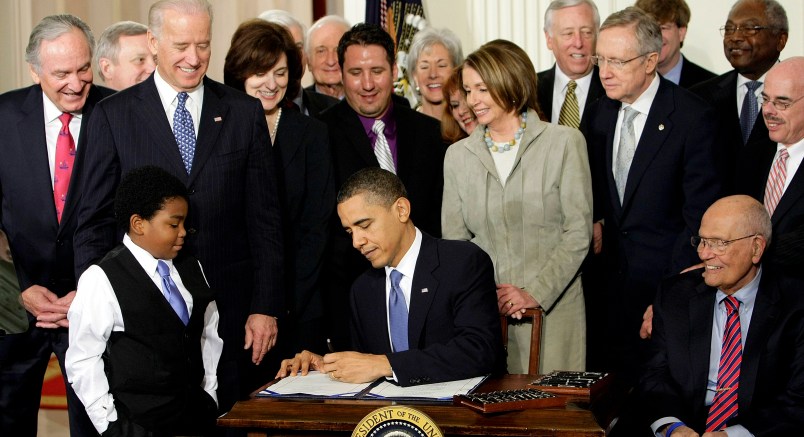Over the last couple days, TPM’s Dylan Scott has been taking a deep look at the emerging Obamacare Subsidy Truth Movement and the history of the legislation that gave rise to it. I wanted to make sure you didn’t miss them because they’re exceptionally good pieces and examples of the longer, reported pieces we’ll be doing more of. The first piece looks at the chaotic, late phase of the passage of the ACA, with House Democrats wanting a single federal exchange and the Senate wanting a state based approach. The battle over which side would win was short-circuited by the surprise election of Sen. Scott Brown, which robbed Senate Democrats of their filibuster proof majority and essentially forced the House to accept the Senate’s bill more or less intact.
The second looks at one of the many – but thus fairly relatively unexplored – reasons why we know the Subsidy Truther argument doesn’t hold up. At the time the bill’s passage hung in the balance, there were repeated CBO scorings of different versions of proposed legislation since a critical part of the politics was whether reform would pay for itself. In short, the CBO, the branch of government of government charged with analyzing the budgetary impact of federal legislation never considered the idea that subsidies wouldn’t be available through a federal exchange. This evidence is contemporaneous, from the agency charged with analyzing all possible ramifications of the legislation. And the Subsidy Truther argument was so far from anyone’s understanding of the bill that it wasn’t even thought of let alone entertained.
The response from the key players in the Subsidy Truth Movement has been, well, the conspiracy runs just that deep, or rather the CBO was just one more player in the drama who didn’t understand what the bill actually did or how it could work in practice. No one thought any state would run the risk of the subsidy cut off embedded in the ACA. So they didn’t even consider it. Or even the CBO didn’t understand the details of the ACA later discovered by a group of conservative lawyers trying to cripple the law years later. Or maybe they didn’t read it. Or CBO analyses are really never that exhaustive.
One TPM Reader TS put it, the theory makes no sense “when you consider that CBO routinely responds to Congressional requests to consider alternative scenarios, to cost them out. So if ANYONE in Congress at the time had considered the partial subsidies approach, a money saver, they would have asked for a CBO estimate. This is the hardest of hard evidence of Congressional intent.”
In other words, the CBO now joins other groups, like the authors of the legislation, the journalists who covered the debate and the key industry stakeholders, who apparently never understood how the law worked. Much like the armchair engineers and metallurgists who got to the bottom of the destruction of the Twin Towers that professional experts missed or covered up and the weekend document analysts who broke open the fraud concealing the President’s foreign birth, it remained for a group of conservative legal activists with no deep understanding of the ACA, the policy debate over it, the contemporaneous reporting of its debate and passage, or any acquaintance (personal or professional) with the bill’s actual authors to finally divine the true intent behind the legislation.






